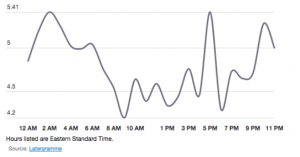
When it comes to sourcing quality talent, employee referrals have been shown to outpace just about every other recruiting source.
In fact, 46% of candidates referred to a company through an employee referral program end up staying at least a year with the company, compared to just 33% from job boards on a company website, and 22% from a third party job board site.
Additionally, a recent Jobvite Index shows that only 6.9% of candidates are sourced through referrals, 39.9% of hires are done through referrals. Additionally, application-to-hire time frame is shorter, and the employee referrals stay longer.
In terms of the advantages of employee referral programs, LinkedIn’s Paul Petrone puts it this way: “getting a referral is a cheaper way to hire, a faster way to hire, generally produces a better hire and lowers the turnover rate at your company.”
Providing Employees with Data for Even Better Referrals
We’ve mentioned in previous posts that employee referrals are the top source of quality candidates, and are also one way to help lighten the load of HR. Additionally, according to research conducted by iCIMS:
- Employee referrals stay longer
- Referred employees are more satisfied
- Referred employee satisfaction increases over time
So how can you aid your employees in their referral recruiting efforts?
Among creating a user-friendly process, determining the goal of your referral program, and clarifying what employees can expect when they refer a candidate, Petrone lists providing the proper information about the open job’s qualifications can encourage employees to refer good people.
And this is where data provided by tools like a job analysis is going to be helpful.
The essential responsibility of a job analysis is to define the job itself. This includes not only technical skills, but also competencies considered valuable.
For example, a sales associate may need good listening skills which might not be a priority for somebody in customer service. A customer service representative may have greater need of product knowledge or policies and procedures.
When looking to fill a new position, management can provide employees with information from the job analysis.
Petrone states that detailing exactly what your company is looking for in referred candidates is imperative to the success of your referral program, since even one variation between skillsets can make a major impact on your bottom line. While employees who are part of the corporate culture may have a better understanding of what is really needed, Petrone writes, employee referral program training presents an opportunity to discuss what skills are required by various jobs.
Employee referral programs are a very cost-effective way of filling positions. Companies can add considerable quality to the effort by making use of job analysis information. The market is a tough place to do business, and competition never rests. With some information and proper guidance, employees can be a valuable source of highly qualified individuals for any job vacancy.
For more information on talent acquisition ideas, download your free copy of 5 Talent Acquisition Commandments for Every Productive Mass Hiring Team.
Business & Finance Articles on Business 2 Community
(82)








